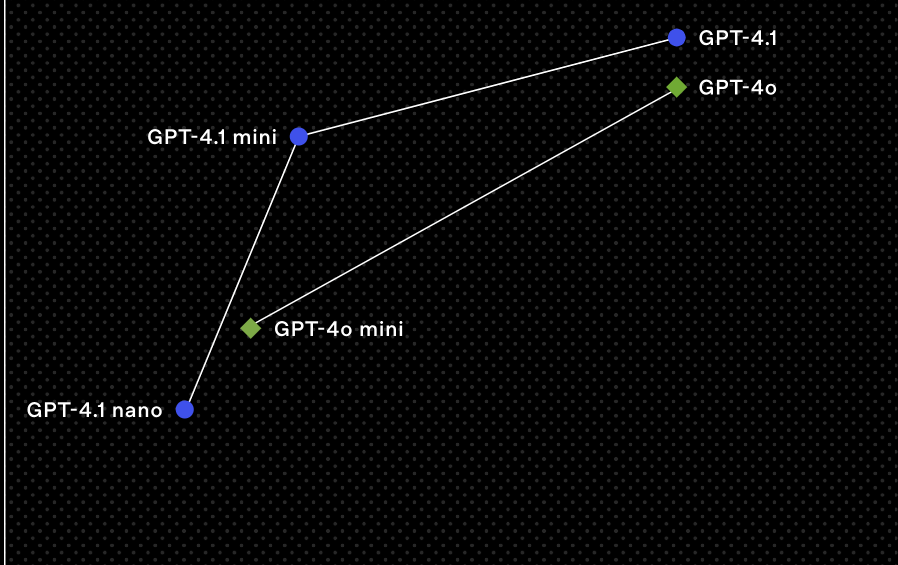
GPT-4.1 Arrives: Faster, Smarter, and Built for Big Tasks
OpenAI has launched a new family of models called GPT-4.1. These models are now available through its API and bring big improvements in speed, cost, and intelligence. If you’re a developer, researcher, or business looking to build smarter AI-powered tools, this release matters.
GPT‑4.1 is designed to solve coding problems, follow instructions more accurately, and handle longer documents better than ever. It even outperforms the previous top-tier models like GPT‑4o and GPT‑4.5 Preview. With better performance and lower prices, it’s now easier for more people to build powerful applications with AI.
Three Models, Three Strengths
The GPT-4.1 family includes three models: GPT‑4.1, GPT‑4.1 mini, and GPT‑4.1 nano. Each serves a different purpose.
The main GPT‑4.1 model is the strongest. It’s great for tasks like writing code, reading long documents, and building helpful agents that complete tasks. It understands 1 million tokens of context—about the size of a large book. This helps it stay on track during long conversations or when reading big files.
GPT‑4.1 mini is faster and cheaper than GPT‑4o but still very smart. It works well for common AI tasks while cutting latency in half and reducing cost by 83%.
GPT‑4.1 nano is the smallest, fastest, and most affordable. It’s perfect for things like auto-completion, classification, or chatbot responses. Despite its size, it performs better than GPT‑4o mini in many key tests.
GPT-4.1 a Big Deal for Coders
If you write code, GPT‑4.1 makes life easier. It scores 54.6% on the SWE-bench Verified test—a big jump from GPT‑4o’s 33.2%. That means it’s better at fixing bugs, completing tasks in real codebases, and writing useful software.
It also follows code formatting better. Whether you want to rewrite a whole file or just output changed lines, GPT‑4.1 handles both options well. This makes it faster and cheaper to work with code in real-time.
Smarter with Instructions and Long Reads
GPT‑4.1 follows instructions better than earlier models. It scored 38.3% on MultiChallenge, which tests how well it listens and acts. This is 10.5% higher than GPT‑4o.
It also understands videos and long documents better. On the Video-MME test, GPT‑4.1 scored 72.0% in understanding long video content with no subtitles. That’s a record score. It means GPT‑4.1 can help users extract meaning from hours of content more effectively.
Built for Real-World Use
OpenAI didn’t just focus on benchmarks. They worked with real developers who tested GPT‑4.1 on real tasks. From legal tech to finance to customer support, this model powers tools that actually work in production.
The models can run faster thanks to better backend systems. This lets developers build tools that feel snappy, even when working with large files or complex workflows.
Affordable and Scalable
GPT‑4.1 is also cheaper to run. It costs 26% less than GPT‑4o for common tasks. For developers repeating the same context (like a prompt template), OpenAI now offers a 75% discount on cached tokens—up from 50%. And there’s no extra fee for using the long context window.
Goodbye GPT‑4.5, Hello Future
With GPT‑4.1’s release, OpenAI will shut down GPT‑4.5 Preview by July 14, 2025. Developers should start switching to GPT‑4.1 now. It gives similar or better performance with less waiting time and lower cost.
Where to Learn More
Developers can access GPT‑4.1 and its smaller versions today through the OpenAI API. To explore features, pricing, and how to get started, visit the official page here: https://openai.com/index/gpt-4-1/.
In short, GPT‑4.1 marks a big leap for AI tools. Whether you need to code, read, answer, or automate, it’s now easier—and cheaper—to build something that works.
